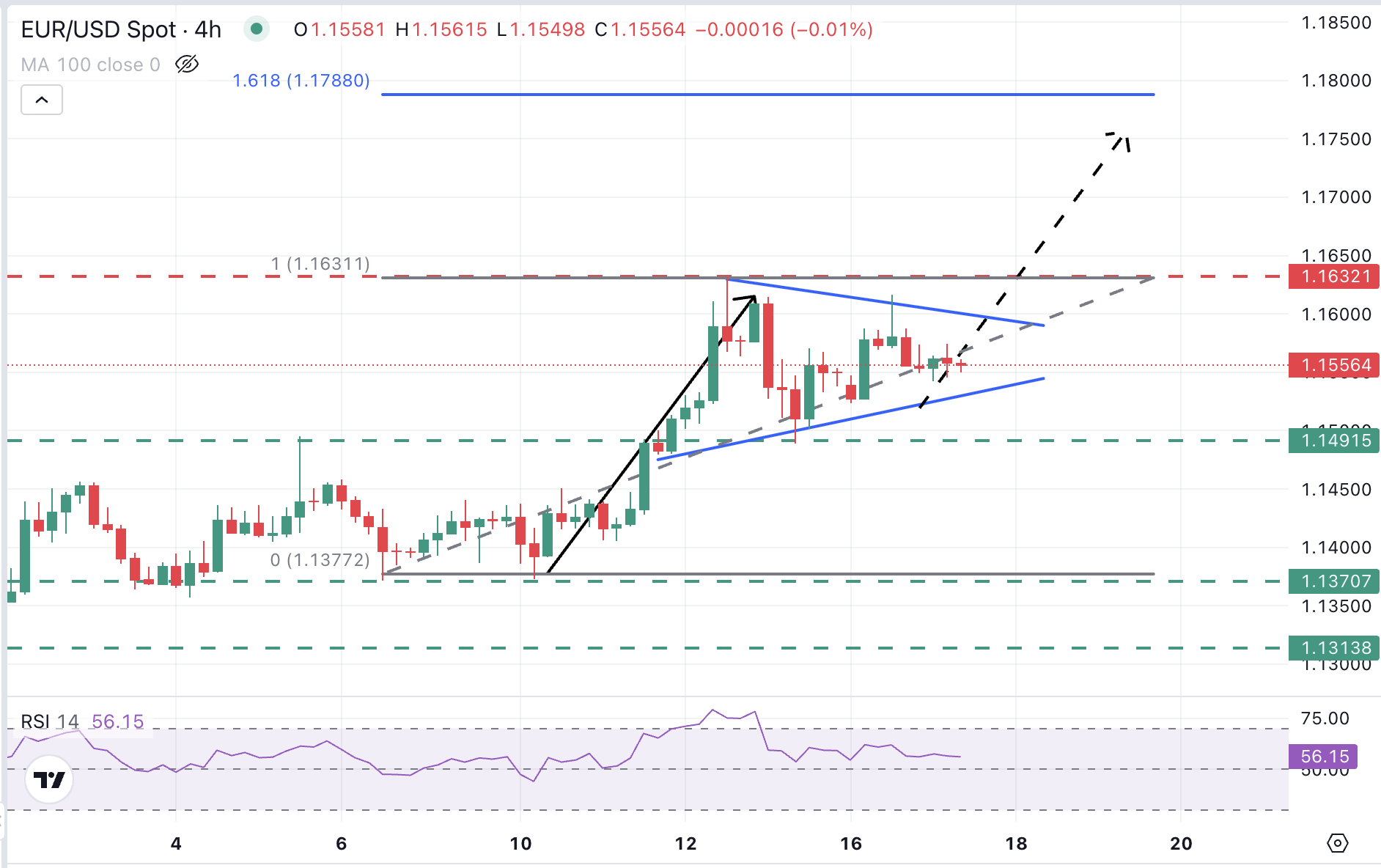- The euro is falling, affected by risk aversion.
- The escalation fears in the Middle East conflict are supporting the US dollar.
- The EUR/USD moves inside a small triangle pattern around 1,1550.
The Eur/USD It is quoting with marginal losses, in the middle of the range of 1,1500 on Tuesday. The decreasing hopes of a high fire in the Middle East have cooled The appetite for riskbut market volatility remains contained so far while investors expect a series of monetary policy decisions, including that of the Federal Reserve (FED) later this week.
Israel and Iran have continued exchanging fire during the fifth day, and US President Donald Trump has urged citizens to evacuate Tehran, before leaving the G7 summit a day before to meet with the National Security Council. The concerns that the US could be involved in the conflict have increased risk aversion.
However, market movements are still limited so far, with investors observing from the lateral line before the US retail sales data, which will be published later on Tuesday, and the result of the FED monetary policy meeting, Wednesday.
It is widely expected that the Central Bank keeps rates without changes, but investors will be particularly attentive to the summary of economic projections and possible variations in the points graph to evaluate the trajectory of the trajectory of the interest rates in the short term.
Euro price today
The lower table shows the percentage of euro change (EUR) compared to the main currencies today. The euro was the strongest currency against pound sterling.
| USD | EUR | GBP | JPY | CAD | Aud | NZD | CHF | |
|---|---|---|---|---|---|---|---|---|
| USD | 0.04% | 0.19% | 0.04% | -0.01% | -0.13% | -0.24% | -0.15% | |
| EUR | -0.04% | 0.12% | 0.03% | -0.07% | -0.14% | -0.20% | -0.21% | |
| GBP | -0.19% | -0.12% | -0.16% | -0.19% | -0.26% | -0.36% | -0.33% | |
| JPY | -0.04% | -0.03% | 0.16% | -0.06% | -0.17% | -0.27% | -0.21% | |
| CAD | 0.00% | 0.07% | 0.19% | 0.06% | -0.19% | -0.15% | -0.14% | |
| Aud | 0.13% | 0.14% | 0.26% | 0.17% | 0.19% | -0.07% | -0.07% | |
| NZD | 0.24% | 0.20% | 0.36% | 0.27% | 0.15% | 0.07% | -0.00% | |
| CHF | 0.15% | 0.21% | 0.33% | 0.21% | 0.14% | 0.07% | 0.00% |
The heat map shows the percentage changes of the main currencies. The base currency is selected from the left column, while the contribution currency is selected in the upper row. For example, if you choose the euro of the left column and move along the horizontal line to the US dollar, the percentage change shown in the box will represent the EUR (base)/USD (quotation).
What moves the market today: the US dollar recovers its safe shelter status
- Trump’s hurried departure from the G7 summit has increased concerns that the US could be involved in the Israel-Iran conflict. The news has crushed the appetite of investors for the risk and has provided some support to the US dollar due to a greater demand for safe assets.
- Israel and Iran continued exchanging missiles before that. Iran promised to launch its greatest missile attack in history against Israel, while Israeli Prime Minister Benjamin Netanyahu threatened to kill the supreme leader of Iran, Ali Khamenei. Meanwhile, Trump’s call to the citizens of Tehran to leave the city has fed concerns about a serious escalation of the conflict.
- The market reaction has been risky, although with limited volatility so far. The operators are waiting, waiting for the decision on the Fed interest rate later in the week. The American dollar index (DXY), which measures the value of the USD compared to a basket of the most negotiated currencies, moves just above the level of 98.00, not far from the minimum of several years of last week.
- The Zew economic feeling index in Germany has improved beyond expectations, rising to 47.5 in June from 26.2 in May, exceeding the market forecasts of a 35.0 reading. However, the data has failed to provide significant support to the euro.
- The main approach today will be in the US retail sales data, which is expected to show a significant contraction of 0.7% in May after a growth of 0.1% in April, showing more evidence of the negative impact of tariff turbulence in the US economy.
- The highlight of the week will be the monetary policy decision of the Federal Reserve on Wednesday. The bank will probably maintain its reference interest rate without changes in the current range of 4.25%-4.5%, but investors will be attentive to changes in interest rates projections, which pointed to two more cuts this year, as well as to growth and inflation forecasts.
- The US data published on Monday revealed a strong deterioration of the manufacturing index of the Fed in New York, which fell to a reading of -16 in June, in the face of the expectations of a moderate improvement to -5.5 from -9.2 in May.
Technical analysis: EUR/USD forming a small triangle around 1,1550

EUR/USD He has been moving inside an increasingly narrow range since he reached a peak above 1,1600 last week, forming a small triangle. Technical studies indicate that this is a continuation pattern, suggesting a bullish result.
The upper part of the triangle, now around 1,1600, will probably keep the Alcistas before the maximum of June 12 in 1,1630. Above here, the psychological level of 1,1700 could attract vendors. The measured target of the triangle pattern is 1,1750.
In the lower part, the triangle has a support in 1,1525 before the minimum of June 13 in around 1,1490. Below here, the upward trend would be questioned, with the pressure increasing around 1,1370 (minimum of June 6 and 10).
US dollar FAQS
The US dollar (USD) is the official currency of the United States of America, and the “de facto” currency of a significant number of other countries where it is in circulation along with local tickets. According to data from 2022, it is the most negotiated currency in the world, with more than 88% of all global currency change operations, which is equivalent to an average of 6.6 billion dollars in daily transactions. After World War II, the USD took over the pound sterling as a world reserve currency.
The most important individual factor that influences the value of the US dollar is monetary policy, which is determined by the Federal Reserve (FED). The Fed has two mandates: to achieve price stability (control inflation) and promote full employment. Its main tool to achieve these two objectives is to adjust interest rates. When prices rise too quickly and inflation exceeds the 2% objective set by the Fed, it rises the types, which favors the price of the dollar. When inflation falls below 2% or the unemployment rate is too high, the Fed can lower interest rates, which weighs on the dollar.
In extreme situations, the Federal Reserve can also print more dollars and promulgate quantitative flexibility (QE). The QE is the process by which the Fed substantially increases the flow of credit in a stuck financial system. It is an unconventional policy measure that is used when the credit has been exhausted because banks do not lend each other (for fear of the default of the counterparts). It is the last resort when it is unlikely that a simple decrease in interest rates will achieve the necessary result. It was the weapon chosen by the Fed to combat the contraction of the credit that occurred during the great financial crisis of 2008. It is that the Fed prints more dollars and uses them to buy bonds of the US government, mainly of financial institutions. Which usually leads to a weakening of the US dollar.
The quantitative hardening (QT) is the reverse process for which the Federal Reserve stops buying bonds from financial institutions and does not reinvote the capital of the wallet values that overcome in new purchases. It is usually positive for the US dollar.
Source: Fx Street
I am Joshua Winder, a senior-level journalist and editor at World Stock Market. I specialize in covering news related to the stock market and economic trends. With more than 8 years of experience in this field, I have become an expert in financial reporting.







